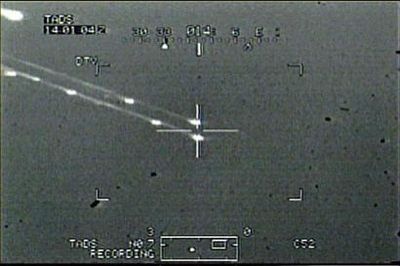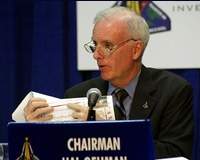But No One Knew It Was Necessary
It would have been possible. It might have happened. But no one
knew a rescue of the seven astronauts aboard the doomed shuttle
Columbia was needed.
That's according to NASA, in testimony and documents before the
Columbia Accident Investigation Board. The rescue would have been
"technically possible, but very, very risky," according to CAIB
spokesman Tyrone Woodyard in an interview with Reuters.
How It Might Have Happened: Two Scenarios
 Had the space agency known about the damage to
Columbia's left wing - damage that the CAIB believes caused the
space plane to break up as it re-entered Earth's atmosphere Feb. 1,
the shuttle Atlantis might have been pressed into
emergency service. Atlantis was scheduled to fly on March 1, but
NASA says launch preps could have been dramatically speeded up.
Had the space agency known about the damage to
Columbia's left wing - damage that the CAIB believes caused the
space plane to break up as it re-entered Earth's atmosphere Feb. 1,
the shuttle Atlantis might have been pressed into
emergency service. Atlantis was scheduled to fly on March 1, but
NASA says launch preps could have been dramatically speeded up.
In a second alternative, reminiscent of the in-flight emergency
work that saved the crew of Apollo 13 after a disasterous on-board
explosion, Plan B would have been to have the crew of STS-107
repair the damage themselves, using whatever materials they had on
board.
The key to the Columbia tragedy is that no one knew
there was a problem with the shuttle until just seconds before it
disintegrated. If NASA officials had known the extent of the wing
damage, Woodyard said, the agency would have done "everything
possible" to rescue the crew. "Doing nothing is just not an option
if they had known the extent of the damage."

NASA could have found out. There were suspicions of damage that
might have been caused 82 seconds after lift-off, when chunks of
foam insulation parted from the shuttle's huge external fuel tank
and impacted the left wing. The National Reconnaisance Office
offered to retask spy satellites to take pictures of the
Columbia in orbit. NASA officials, however, turned down
the offer, believing the damage to the shuttle itself was minimal.
They were tragically wrong.
Now, as part of its initial recommendations, the CAIB strongly
suggests pictures always be taken of shuttles in flight as a way to
guard against just the sort of damage that killed
Columbia.

We May Never Know.
And That May Not Be So Bad.
Although the CAIB probe is focused now on the damage to the left
wing, there is still no consensus on how that damage occurred.
Again, the break-away insulation could have indeed caused
structural damage on the leading edge of the left wing. Then again,
it could have been space debris or something else as yet
unsuspected.
 But is
that a bad thing? Perhaps not, says Board Chairman Harold Gehman
(Adm., USN, retired). "It may be that the fact we don't have a
cause-and-effect that hits us in the head like a two-by-four is a
blessing in disguise," Gehman told reporters last week. The CAIB
will issue its final report before the end of summer, probably
citing a cascade-scenario familiar to those who follow aviation
mishaps: "multiple causes and multiple flaws," according to Gehman.
"Complex systems sometimes fail in complex ways. Sometimes you have
to work pretty hard to pin down those complex failure mechanisms.
But if you can do that, you will have done the system a great
service."
But is
that a bad thing? Perhaps not, says Board Chairman Harold Gehman
(Adm., USN, retired). "It may be that the fact we don't have a
cause-and-effect that hits us in the head like a two-by-four is a
blessing in disguise," Gehman told reporters last week. The CAIB
will issue its final report before the end of summer, probably
citing a cascade-scenario familiar to those who follow aviation
mishaps: "multiple causes and multiple flaws," according to Gehman.
"Complex systems sometimes fail in complex ways. Sometimes you have
to work pretty hard to pin down those complex failure mechanisms.
But if you can do that, you will have done the system a great
service."
Gehman said, while the Columbia tragedy may never be
firmly traced back to the break-away insulation foam from the
external fuel tank, "We are going to tell them to fix the foam
shedding, absolutely." The falling foam is only a symptom of a
troubling pattern in which the flight team somehow "rationalized"
such problems as normal and acceptable, he said.
 Unfortunate... ANN/SportPlane Resource Guide Adds To Cautionary Advisories
Unfortunate... ANN/SportPlane Resource Guide Adds To Cautionary Advisories ANN FAQ: Turn On Post Notifications
ANN FAQ: Turn On Post Notifications ANN's Daily Aero-Term (04.29.24): Visual Approach Slope Indicator (VASI)
ANN's Daily Aero-Term (04.29.24): Visual Approach Slope Indicator (VASI) ANN's Daily Aero-Term (04.28.24): Airport Marking Aids
ANN's Daily Aero-Term (04.28.24): Airport Marking Aids ANN's Daily Aero-Linx (04.28.24)
ANN's Daily Aero-Linx (04.28.24)






